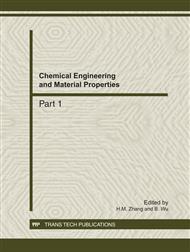p.1273
p.1278
p.1283
p.1287
p.1291
p.1296
p.1302
p.1306
p.1311
Fabrication and Photocatalytic Activities of TiO2 Nano-Films Deposited at Different Ar/O2 Flow Ratios by DC Magnetron Sputtering
Abstract:
Polycrystalline TiO2 nano-films were prepared by DC magnetron sputtering at different Ar/O2 flow ratios. The thicknesses of all the prepared films were about 200 nm. The prepared films consist of a mixture of anatase and rutile phase. The TiO2 nano-films deposited at Ar/O2 flow ratio (1:1) have the best crystallinity and the mixture phase of anatase and rutile. SEM images show that the film surface composed of polygonal particles about 100 nm in diameter. UV–Vis transmission measurements reveal that the band gap of the deposited TiO2 nano-films changed from 3.01 to 3.12 eV. The photocatalytic activities of the TiO2 films were investigated by the decomposition of IPA under UV irradiation. The IPA can be oxidized to acetone and further to CO2. The maximal acetone concentration and CO2 concentration can reach to 29.2 ppm and 4 ppm after 120 min.
Info:
Periodical:
Pages:
1291-1295
Citation:
Online since:
December 2011
Price:
Сopyright:
© 2012 Trans Tech Publications Ltd. All Rights Reserved
Share:
Citation:


